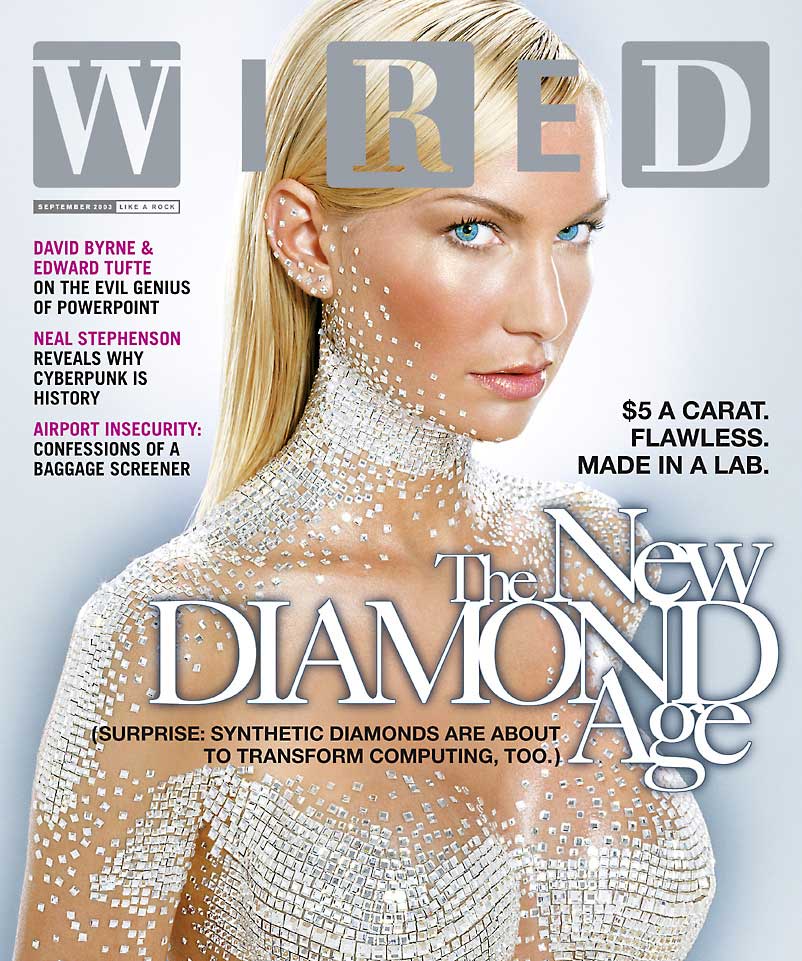IT WAS WEARING ONE OF THOSE UHURU-ESQUE HEADSETS, TELLING A CROWD OF WHITE PEOPLE CLONED FROM ONE OF CHRIS ANDERSON’S STEM CELLS A WARM, WISE, AND WITTY PARABLE OF SUFFICIENTLY GLADWELLIAN COUNTERINTUITIVENESS.

This just in: a flaming brick, neatly wrapped and tied with a pretty pink bow, just in time for International Women’s Day.
When will the smartest, most high-profile women of the tech world band together to form a tactical-media activist group—think: the Guerrilla Girls, but tech savvier—devoted to calling to account WIRED, TED, and other smarmy, self-congratulatory sinkholes of white-guy privilege for their role in perpetuating the perception that tech culture is a White Guy Thing?
To be sure, the underrepresentation of women and people of color in the sciences and in the upper reaches of tech-industry management is the result of an unhappy convergence of socioeconomic factors. But, just as obviously, media representations play a role in shaping peoples’ sense of the avenues of possibility that are open—or closed—to them. The African-American SF visionary Samuel Delany made this point with his usual unstudied eloquence when he told me, in an interview, that the semiotic trappings of traditional “hard” SF in the Asimov mode were understood, by blacks and women, as shorthand for “Keep Out; White Guys Only.”
 Get out your angry bean-counter’s scorecard and take a look at this gallery of WIRED covers and tell me my teenage daughter and her girlfriends won’t get the not-terribly-subliminal message, loud and clear:
Get out your angry bean-counter’s scorecard and take a look at this gallery of WIRED covers and tell me my teenage daughter and her girlfriends won’t get the not-terribly-subliminal message, loud and clear:
 2012: No people of color, no women, a bunch of white guys.
2012: No people of color, no women, a bunch of white guys.2011: Two white guys. Rare sighting of a (white) woman. Bonus point: she’s a Rosie-the-Riveter poster girl for Maker culture.
2010: More White Guys of a Certain Age, no ethnic or racial minorities, some CGI white guys, a pair of breasts on a decapitated body. Valerie Solanas, pink courtesy phone; Valerie Solanas…
2009: The requisite complement of white guys, a vaguely gyndroidal (white) woman who appears to be naked (but of course!) with an artfully airbrushed sideboob and—what’s this? A black man?! Of course, he’s an athlete—what other kind of black man is there, besides musician?—putting a face on a story about Nike.
2008: More white guys, a (white) female customer-support drone in a TECH SUPPORT T-shirt—lest we confuse her for one of the pale, male Captains of Industry fulsomely lionized by the tech press—and, just when you were beginning to worry, a fwap-fwap-friendly cover shoot of Julia Allison, sleek gams up to here, plunging cleavage down to there. “Julia Allison can’t act. She can’t sing. She’s not rich. But thanks to a genius for self-promotion, she’s become an Internet celebrity.” Women We Love, by Wired.
2007: A bumper crop of political correctness! An Asian guy and *three* women! The Asian guy is ethno-correctly equipped with the stereotypic katana (what, no Wong Brothers Laundry Service T-shirt?). The women include an otaku-licious manga babe with pneumatic breasts, a cute dress-for-success corporate babe holding a sign reading “Get Naked” (the feature she’s ballyhooing is about “radical transparency,” hence the punny lad-zine cover art), and Martha Stewart, fondling a pastry bag with a salacious twinkle in her eye. (OKAY, I’m angling for the Overreading Award, having my own private CLAM-PLATE ORGY here, and yes, Martha is a Doyenne of Domesticity so the image makes sense, but Just Look at That Suggestive Sack. Just Look At It.
2006: More white guys, a woman lolling languidly in a tangle of sheets, steaming the mylar off your copy of the magazine with bedroom eyes that say “post-coital languor,” and another cover featuring a pair of big, James Rosenquist-y, concupiscent female lips popping a pill.
I could go on, but why bother? Have yourself a dreary little death march, down through the WIRED years, trying to find a cover with a woman or a person of color who embodies tech savvy or scientific knowledge or business acumen. If there are any, they’re few and far between.
From a casual survey of TED’s hugely popular video clips, the same holds true for the elite, invitation-only conference, which has always struck me as a Bohemian Grove for geeks.
Tell me this doesn’t matter, in a world where kids take their cues—from their vastly extended social networks, sure, and from their parents, certainly—but at least equally from the media.
At a moment when we perceive the world around us, and make sense of it, through media representations, the images women and people of color see of themselves (or not) in the funhouse mirrors of Hollywood, Madison Avenue, Web media, and magazine covers have the power to disempower—or empower; to inspire people of color and young girls to find their own uses for technological innovation and scientific literacy or to resign themselves to walk-on roles, in the white-guy Tomorrowland brought to you by TED and WIRED, as dumb meat, not exalted mind—jocks in Nikes, maybe, or a pair of tits in search of a brain.

